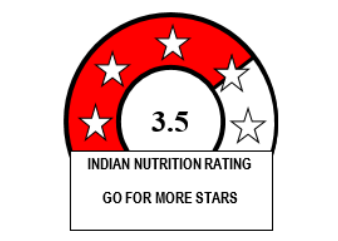Know how Front of Pack Labelling will impact Food Ecommerce Businesses & Food Aggregators
October 26, 2022

The much-awaited, anticipated and even feared by a few Food Manufacturers- Front of Pack Labelling was introduced by the Food Safety and Standards Authority of India (FSSAI) in its draft Regulation on 13th September 2022. The move was to strengthen the Food Labelling ecosystem in India and to offer quick guidance to consumers on the nutrition profile of Packaged Foods. Very soon we will get to see a packet of chips or biscuits mentioning the health stars (out of 5) on its front panel. While most countries such as Australia, New Zealand, Chile, Israel, Peru, Brazil, and Mexico, among others, already have a range of front-of-pack-labelling which indicates to the consumer in 10 seconds how healthy the product is. India too will follow suit, and in a couple of years, the supermarket will be flooded with products denoting the front of the pack label.
What is Front-of-pack nutrition labelling?
As per the definition given by FSSAI: “Front-of-pack nutrition labelling (FOPNL) is a form of supplementary nutrition information that presents simplified nutrition information on the front-of-pack of pre-packaged foods. It can include symbols/graphics, text or a combination thereof that provide information on the overall nutritional value of the food and/or on nutrients included in the FOPNL.” It is quick and easy-to-understand information for consumers at the point of purchase, allowing them to distinguish between healthy and unhealthy food and drink options. Simply put, general people need a clear and easy way to make healthier purchases.
The chosen method by FSSAI to denote this simplified nutrition information on the front panel is through Health Star Rating introduced and adopted by Australia & New Zealand. In the Indian Context, it is named Indian Nutrition Rating (INR), a system wherein product is rated on nutrition parameters and stars are assigned from ½ star (least healthy) to 5 stars (healthiest). More stars indicate that the food product is better positioned to provide for the daily human need for nutrients. The logo format for INR is shown below:
To know more on FOPNL, refer blog: What is Front of Pack Labelling and why is it essential in India?
The chosen method by FSSAI to denote this simplified nutrition information on the front panel is through Health Star Rating introduced and adopted by Australia & New Zealand. In Indian Context, it is named as Indian Nutrition Rating (INR), a system wherein product is rated on nutrition parameters and stars are assigned from ½ star (least healthy) to 5 stars (healthiest). More stars indicate that the food product is better positioned to provide for daily human need of nutrients. The logo format for INR is shown below:

To know more on the study for FOPNL refer blog: FSSAI picks LabelBlind to study baseline nutrition values of packed food products - NUFFOODS Spectrum India
Why Front-of-pack nutrition labelling?
The processed Food Market in India has a 24% growth year on year and is expected to rise further. With urbanization and increased affordability, the food environment in India has changed from traditional home food to more packed, ready-to-eat, snacking and junk food varieties. This has increased lifestyle-related health conditions such as diabetes, obesity and heart conditions. It raises serious concerns about the well-being of average Indians and the future population. FSSAI has recognized the same and hence has introduced the FOPNL. This INR system will help in choosing foods carefully and is preventive in nature for foods that are high fat, high sugar and high salt. Just the way a packet of cigarettes has a warning message which helps discourage its consumption, in the same way, FOPNL will encourage consumers to buy products with more stars. This will not only educate consumers on choosing healthy packaged products but will also keep Food manufacturers on their toes to better their product formulations to achieve more stars. Research conducted on Dutch products showed that many food products were reformulated to denote a better score.
To know more about the impact of FOPNL on consumers refer blog: How do Front-of-Package Nutrition Labels impact consumers?
How will Front-of-pack nutrition labelling impact Food Ecommerce Businesses & Food Aggregators?
The introduction of FOPNL will not only impact consumers and Food Manufacturers but poses to be a sharp alert to Food Ecommerce Businesses & Food Aggregators as well. Food aggregators include Restaurant aggregators that are mediators between customers and local restaurants, and Food eCommerce Businesses are companies that are mediators between customers and Manufacturers. These Players operate through a single website or mobile application. Examples of Food Aggregators include Swiggy, Zomato, and Food eCommerce businesses including Amazon, BigBasket, etc.
Although these Players act as online platforms in the transaction between consumers and Brands, FOPNL is expected to impact them hugely. FOPNL is voluntary from 2023 and will be mandatory from 2027. Hence all necessary steps towards ensuring compliance need to be readied early on.
Food Ecommerce Businesses & Food Aggregators will need to apprise Food Business Operators of this mandatory regulation so as to ensure all products listed on their websites are FOP regulation compliant. Information and details of the food production required to generate the INR would have to be in order. These players would be greatly impacted by this, as the scale and nature of this exercise would be huge for them. In the case of Food aggregators, although they have their major chunk of business in the fresh food sector such as delivering restaurant-ordered food, however, some part of their business also caters to food manufacturers offering prepared food that is packaged and sold. Examples include sandwiches, burgers, and desserts, that are packaged. Hence these will need to show INR on the front of their packs.
Food Ecommerce Businesses & Food Aggregators would also have to ensure the smooth onboarding of products that are FOPNL compliant. Getting compliant-ready products across their platforms would be a major task for them.
These players would also have to offer solutions and guidance to Food Business Operators to transition their conventional labels to FOPNL-compliant labels. This would be in the form of Q&As, Regulatory help and FOPNL tools for easy INR assessment and subsequent deployment on packaging designs.
High-star-rated products can be encouraged by Food Ecommerce Businesses with preferential/noticeable listing to support positive consumer choices. Hence the juggle would be to reformulate products in such a way as to achieve more stars by cutting down on fat, and sugar. Food Ecommerce businesses would also have to work towards ensuring the maximum number of products listed on their website have more stars.
Food Ecommerce Businesses & Food aggregators can tag high star rated products by consumer preferences and needs (low sugar, high protein, high fibre, low salt) to make selections easy. Marketing products with fewer stars on the website would be a major blow to any food aggregator. Hence, they would have to strengthen product development in such a way as to better position the products on their website. As high star rated products will be preferred by consumers.
Food Ecommerce Businesses & Food Aggregators would also have to ensure that Product descriptions and advertising claims listed on their platforms must support INR.
Customer queries on nutrition quality will need to be managed with scientific explanations and suggestions by Food Aggregators.
And lastly, cases of mislabelling will also have to be addressed in a predictive manner as well as identified for prompt correction. As this would be an important piece for their business.
Conclusion
FOPNL is a new regulation brought by FSSAI for all packaged food manufacturers that allow consumers to view the nutrition profile of a product in just a few seconds. This is thought to impact consumers on their eating choices, selection of only healthy products and Food manufacturers to reformulate their products so as to achieve more stars. Food Ecommerce Businesses & Food aggregators will also be immensely impacted by this rule as they would now have to ensure all packaged food products offered on their websites are not just compliant but also showcase more stars to build consumer trust. However, there is still little evidence on how FOPNL will decrease lifestyle-related disorders and improvements in eating habits in the long run. For that, I guess we all need to wait and watch!
References
FSSAI introduces Front of package label campaign (packagingsouthasia.com)
Colour coding or star rating—FSSAI food labelling plan can trigger a new nutrition war (theprint.in)
FSSAI Food Safety and Standards (Labelling and Display) Regulations, 2020.
https://fssai.gov.in/upload/notifications/2020/12/5fd87c6a0f6adGazette_Notification_Labelling_Display_14_12_2020.pdf
Draft Notification Food Safety and Standards (Labelling & Display) Amendment Regulations, 2022 (Front of Pack Nutritional Labelling (FOPNL) and High fat, sugar, salt (HFSS))
Draft_Notification_HFSS_20_09_2022.pdf (fssai.gov.in)
Front of Package Labelling (FOPL) System (drishtiias.com)
Front-of-Pack Nutrition Labelling (FOPNL).pdf (unicef.org)
What is Food Aggregator | IGI Global (igi-global.com)
The influence of a front-of-pack nutrition label on product reformulation: A ten-year evaluation of the Dutch Choices programme - ScienceDirect

Olivia Crasto (MSc in Food Processing & Preservation)
Olivia is a Learner for Life, Eco enthusiast and loves to experience nature and its beauty
